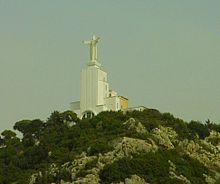Nahr Al-Kalb

Historical Significance
The Nahr al-Kalb is the ancient Lycus River. The river mouth is renowned for its Commemorative stelae of Nahr el-Kalb, featuring inscriptions from various civilizations. Past generals and conquerors have traditionally built monuments at the mouth of the Nahr al-Kalb, known as the Commemorative stelae of Nahr el-Kalb. The notable inscriptions are of: Assyrian, Babylonian, Roman, Crusader, Ottoman, and modern era.
The entire site of the Nahr el-Kelb valley with the archaeological sites it conceals is classified on the indicative list of UNESCO world heritage.
Geography
The river originates at a low altitude from a source that originates from the Jeita Grotto.
Recent Developments
As of February 2025, the site remains a focus of historical research and preservation. In November 2023, digital documentation of the cuneiform inscriptions was carried out to support their preservation and study.
Notes
- ^ "Commemorative stela of Nahr el-Kalb, Mount Lebanon | United Nations Educational, Scientific and Cultural Organization". www.unesco.org. Retrieved 2018-06-26.
- ^ "Stelae of Nahr el-Kalb". Atlas Obscura. Retrieved 2025-02-02.
- ^ Centre, UNESCO World Heritage. "Lebanon - UNESCO World Heritage Convention". UNESCO World Heritage Centre. Retrieved 2023-12-07.
- ^ "Nahr El Kalb Cuneiform inscriptions, Lebanon". Factum Foundation. Retrieved 2025-02-02.
33°57′N 35°36′E / 33.950°N 35.600°E